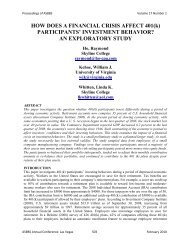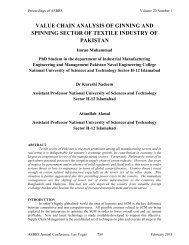stock repurchase announcements: a test of market ... - Asbbs.org
stock repurchase announcements: a test of market ... - Asbbs.org
stock repurchase announcements: a test of market ... - Asbbs.org
Create successful ePaper yourself
Turn your PDF publications into a flip-book with our unique Google optimized e-Paper software.
Property Taxes in Indiana<br />
In 20 03 new housin g in vestment in L ake Count y f ell about 0. 25% below th e state’ s<br />
average <strong>of</strong> 1.03%. It was argued at the time that this shortfall is due to the sharp increase in the<br />
tax burden i mposed on h omeowners. Indeed, pr operty tax rat es in Lake Count y were (and<br />
remain) higher than the state’s average and new housing investment was lower. However, the<br />
coefficient for the property tax variable is actually positive and significant. Likely this means that<br />
prospective homebuilders view the higher rate as indicative <strong>of</strong> public services <strong>of</strong>fered in the<br />
county. Unless we include controls for the services <strong>of</strong>fered, interpretation <strong>of</strong> this result is unclear,<br />
if not useless.<br />
Using the coefficients in Table 2 an d basic data regarding Lake County vs. other<br />
counties, it is actually Lake County’s higher unemployment rate and higher unit construction cost<br />
that explain the vast m ajority <strong>of</strong> this shortfall and actually ove rshoots the difference. Lake<br />
County’s unemployment rate was 1.2% higher than the rest <strong>of</strong> the state. Given the coefficient for<br />
the UE variable, this translates into roughly a .20% shortfall in new investment, or about 80% <strong>of</strong><br />
the 0.25% deficit. Also, Lake Count y’s significantly higher unit construction costs account for<br />
0.22%. It is important to remember we have not controlled for the size <strong>of</strong> the homes being built<br />
or land value s. Lake Count y’s slightly higher median income, younger p opulation pr<strong>of</strong>ile and<br />
higher median home value work to partially counteract the unem ployment and cost effects. In<br />
sum, Lake Count y’s unemployment rate and cons truction costs are enough to m ore than explain<br />
the short-fall in new investment.<br />
Ideally, to m ore full y understand the re lationship b etween property tax rates and new<br />
housing investment additional data needs to be included in the study. As mentioned above, it will<br />
be necessary to include controls for the quality and mix <strong>of</strong> public services purch ased by property<br />
taxes. Proxies might include county expenditures, school performance measures, crime statistics,<br />
and the li ke. As well, it would be ideal if land prices and new housing characteristi cs could be<br />
included.<br />
Different estimation techniques may be advantageous, too. The variables comprising our<br />
simple model presented in Table 2 were chosen in a somewhat ad hoc fashion. While not always<br />
favored in the econo mic l iterature, both stepwise regression or factor analy sis <strong>of</strong>fer alte rnative<br />
approaches to the problem <strong>of</strong> significant correlation among explana tory variables.<br />
Finally, the proxim ity <strong>of</strong> Lake Count y to Chi cago and th e rather high cost <strong>of</strong><br />
homeownership in Illinois, account ing for liv ing costs, econom ic act ivity and r elated<br />
characteristics <strong>of</strong> neighboring areas would add rigo r. Given the rapid housing growth in the<br />
counties neighborin g India napolis’ Mari on Count y – but not Marion itself – may indicate that<br />
suburbanization is an important component.<br />
REFERENCES<br />
deLeeuw, F. and Ekanem , N. F. (19 73). “The Demand for Ho using – A Revi ew <strong>of</strong> the Cross-<br />
Section Evidence.” Review <strong>of</strong> Economics and Statistics, Volume 53, Number 1, 1 – 10.<br />
Himmelberg, C., Mayer, C. and Sinai, T. (2005). “Assessing High Housing Prices: Bubbles,<br />
Fundamentals, and Misperceptions.” The Journal <strong>of</strong> Economic Perspectives, V olume<br />
19, Number 4, 67 – 92.<br />
Lee, T. H. and Kong, C. M. (1977). “Elasticities <strong>of</strong> Housing Demand.” Southern Economic<br />
Journal, Volume 43, 298 – 305.<br />
ASBBS E-Journal, Volume 4, No.1, 2008 147

















